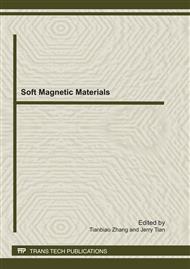p.23
p.29
p.35
p.40
p.45
p.51
p.56
p.63
p.68
Study on the Characterization and Bending Performance of Electro-Active Actuator Based on Cellulose and Poly(3-Hydroxybutyrate)
Abstract:
This paper describes a new electro-active actuator based on cellulose and poly(3-hydroxybutyrate) (PHB) blend film that can produce high bending displacement in room humidity condition. Cellulose based actuator has been reported as a smart material that has merits in terms of lightweight, dry condition, biodegradability, sustainability, large displacement output and low actuation voltage. However, its actuator performance is very sensitive to humidity, which requires high humidity condition for the maximum actuator performance. To overcome this drawback, we introduce cellulose-PHB blend film based actuator. To fabricate this new actuator, cellulose and PHB were dissolved in trifluoroacetic acid. The solution was cast to form a film followed by depositing thin gold electrode on both sides of the film. The morphology of the blend was characterized by scanning electron microscopy. The actuator can be actuated under AC voltage. The bending performance was evaluated in terms of free bending displacement, electrical power consumption output with respect to voltage and frequency and lifetime test at ambient condition. Primary results show that this cellulose- PHB blend actuator is less sensitive to humidity and it shows much high bending displacement and long lifetime (more than 10 hours) at room humidity condition. These results indicate that this new cellulose-PHB blend actuator is promising for many biomimetic applications in foreseeable future.
Info:
Periodical:
Pages:
45-50
Citation:
Online since:
July 2011
Authors:
Keywords:
Price:
Сopyright:
© 2011 Trans Tech Publications Ltd. All Rights Reserved
Share:
Citation:


